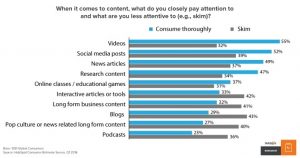
Sometimes even a great website can overstay its welcome. Like a mullet, you might think it makes you look cool, but we all know better.
And like a mullet enthusiast, you might be blind to the problem.
Maybe you’re just too close to your website to notice any issues. Or maybe, because it’s your website, you’ve just ignored it the past couple of years. Either way, you can no longer afford to neglect it.
Your website is your online communications and marketing hub. More than that, it is the cornerstone of all your marketing efforts! It’s that important.
4 Reasons Your Website Needs a Redesign:
- Your design is outdated and the user experience is no good.
- Your website is not mobile friendly.
- You have no SEO or content marketing strategy in place.
- You don’t have a content management system or CMS.
Let’s unpack each of these so you can see what I mean…
Outdated Design and UX
Design
Website design trends can come and go. For example, a few years ago textures were all the rage – lots of deep earthy colors with torn edges, wrinkled paper, etc.
These days websites are much flatter with a minimalist design. This is partially due to the massive increase in mobile audience. Flat designs function much better on mobile devices. More on that in a minute.
Do some objective research to see how your design stacks up to your competition. How do you look? How do they look? What are the first impressions?
Think of it like office decor. You know when you’ve entered an office that hasn’t changed since the 80s. And you know when you’ve walked into a modern space.
Think of the impression each of those gives. First impressions count!
User Experience (UX)
Do you think your website is user-friendly? Are you sure? Remember, you are not your target audience! Try asking some of your clients what they think about your website. Send them a link and maybe questions like…
- How often do you visit our website?
- Is it easy to find what you need?
- What could make it easier?
- Would you recommend our website to others? If so, why? If not, why not?
Tell them to be brutally honest. And then get ready for their answers. You’ll be surprised at how much different your site looks to them.
The best definition I’ve seen for UX is from UX expert Joe Natoli. He gave me this for a presentation and I use it any time I talk about UX…
“UX isn’t just about users; it’s really a value loop in three parts:
- The person using the website has to perceive that it’s valuable to them.
- That perception has to be validated through use. Proof equals trust, which means they use and/or purchase.
- When both things happen, value comes back to the business/creator: increased market share, customer loyalty, money made or money saved.”
If you can build trust and value, you’ll build traffic.
Your Website Is Not Mobile Friendly
This is bad, bad, bad. Mobile users will be frustrated with your site. And Google will penalize you in the mobile listings, it’s that important.
Google has even developed a mobile friendliness test. This will at least give you a preliminary overview of any potential mobile hiccups.
But, it’s more than just phones. Your website should perform well on all devices…
- Androids and iPhones
- Desktops and laptops
- Tablets of various sizes
Your client’s first impression of you could happen on any of these. How do you look? Nervous? Do something about it!
You need to implement responsive design. Responsive design ensures that your website looks and performs effectively on all the devices mentioned above.
Google has recently rolled out AMP or Accelerated Mobile Pages. I’m still not convinced that this is the way to go for all websites. But, if you have a large mobile audience, AMP might be the way to go.
No SEO or Content Marketing Strategy in Place
This is a killer. If you don’t have an SEO and content marketing strategy in place, then the only reason you get traffic is because your website is just plain old. Site history does play a part in search engine rankings but it can easily be trumped.
SEO is the practice of optimizing your website for maximum search engine visibility. This means you’ve optimized things like content, page titles, tags, and other areas of code. So, when the search engines “crawl” your website, they determine if it has value for specific words and phrases.
But optimization without a content strategy is a losing battle. Search engines are looking for a contextual value. They will only list websites they deem to be of value to the user.
A valuable website is a fast loading site that works well on multiple devices AND contains useful content (words, video, etc) that users will love, refer, share, and return to.
Google is judging your website…
- Does it deliver valuable content? Is that content important to your target audience?
- How does it compare in value to websites like it?
- Does it get shares, mentions, likes?
- Is it linked to in other websites, especially popular ones?
- Is it always fresh, updated with new content on a regular basis?
It’s not just keywords. Google is looking for proof – proof that your website holds value for a certain type of user.
No Content Management System or CMS
This should have been at the top of the list. If you can’t update your website content in-house, you’re fighting a losing battle.
A CMS allows you to update your website’s content without any advanced coding knowledge. Without a CMS you are at the mercy of your marketing firm or web design firm to make updates for you. Or worse, you rely on your IT department who have much better things to do.
This is a bottleneck you can’t afford – especially in today’s fast-paced economy.
With a CMS you can update offers, articles, press releases, videos, and so much more.
Without a CMS you have no content marketing strategy. It simply isn’t possible. And without a content marketing strategy, you have no viable SEO solution. This means no traffic.
Your website might as well be a brochure on the ground getting stepped on.
There are lots of content management systems out there for you to choose from. Generally, we recommend WordPress and sometimes Drupal. Both are open source and well supported.
There is Hope for Your Website Yet!
Your website may have been developed during the Bush presidency but there’s still hope. You have history on your side but, you’re living on borrowed time at this point.
Whether you use Wood Street or another web design firm, just make sure you think through the issues above and development a solid plan for your new site.
Good luck and happy marketing!
Digital & Social Articles on Business 2 Community(62)






